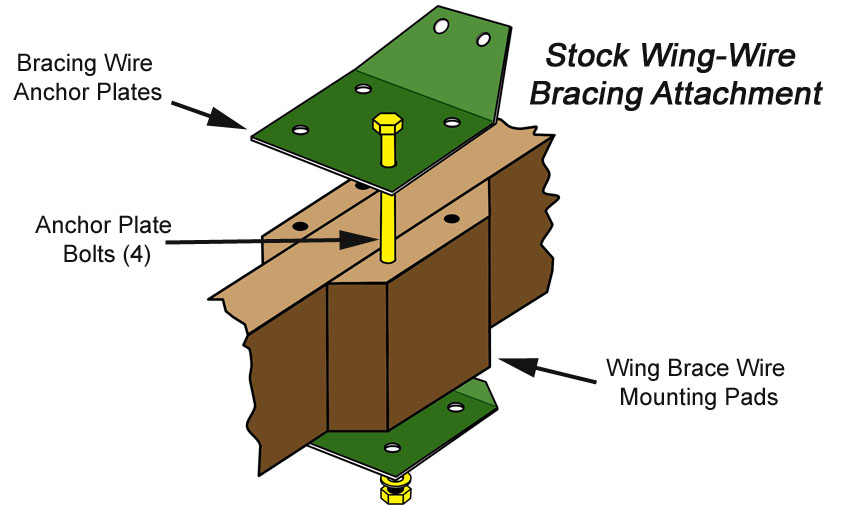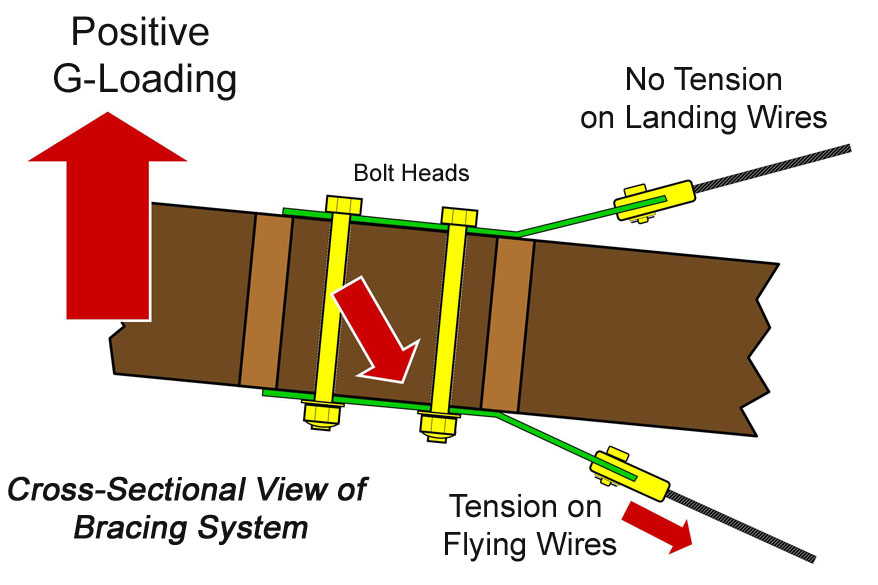
On April 4, 2007, Fly Baby N101LX lost a wing while flying in
Arizona. The pilot was killed. The NTSB
report ruled that the Probable Cause was "The pilot exceeding the
design stress limits of the aircraft while maneuvering in intentional
aerobatics."
The airplane had a number of modifications, including solid bracing
wires and the split landing gear. While this immediately focused
my attention, my suspicions were unfounded. The NTSB found
no problems with them, or the wing bracing anchor plates. The
owner of the aircraft was well-aware of the previous problems.
According to a relative, the pilot had owned the airplane for more than
fifteen years, and the previous year he had removed the wings and had
the appropriate fittings "X-Rayed and chemically checked."
The failure mechanism was frankly unusual. The wing anchor plate
bolts
themselves failed. To quote the NTSB report:

I spoke to the NTSB investigator several times about this accident,
and the failure of the bolts. No previously-existing problems
were found with them... no evidence of fatigue, corrosion or
other deterioration. They failed in
overtension...being pulled too hard. With no other evidence of
casual events, the
investigator's finding was that the bolts themselves failed.
(As an aside, I had a bolt fail in my tail spring mounting system a
few years ago. Under a microscope, you could easily see a track
of corrosion from some sort of surface flaw, that let the bolt
gradually get eaten through from the inside. If the bolts on
N101LX had a flaw that led to their failure, the NTSB would have found
it.)
We don't know why the bolts were overstressed. It may have been an aerobatic maneuver gone wrong. It may have been the sudden onset of a medical emergency (the drug Amlodipine mentioned in the NTSB report is a high blood-pressure medicine), but one would assume the autopsy would have uncovered it. It may have been some other sort of failure that precipitated a high-G reaction, although there is apparently no evidence of other causes.
What I find unusual about this case is that the bolts failed at the head. To me, logic says
that failures at the thread end would be more likely

The diagram above is a cross-sectional view of the wing spar at the
point where the wing wires attach. Standard practice for
installing bolts on aircraft is to place the head
on the upper side, so that if the nut comes off, gravity will keep the
bolt in place. When undergoing positive Gs, the Landing Wires
atop the wing aren't under any load...as any Fly Baby can testify,
they're a bit slack and usually flopping in the wind.
All the flight load is carried by the Flying Wires under the
wing. The Flying Wires' tension is transmitted to the lower
anchor plates, which the vertical bolts hold in place.
However, because of the way the plates attach, it seems to me that
the plates would be applying a bit of side force to the bolts, as well
as tension. To me, then, the friction of the bolts in
their holes would relieve some of the tension on the heads and make
failure at the threaded end more likely. The NTSB investigator
said that the bolt holes in the pads were sleeved, however, so
there wouldn't be as much friction (Sleeving these bolt holes is per
plans, although Pete says it isn't required).
With some of the load on the bolt head relieved by the friction of
the side load, it seems likely that a failure of the head end of the
bolts had to be precipitated by negative
Gs...the top anchor plate had to be pulling hard on the bolt heads.
However, it doesn't seem logical that the wing was subjected to a
failure level of negative Gs. Flying upside down is one thing,
but packing on multiple negative Gs is another thing entirely.
This is not "normal" aerobatics, unless one is heading towards the
competition/airshow world. And it doesn't seem likely someone
would be practicing such in a 65-HP Fly Baby.
However, Steve Garrison, a participant in the Fly Baby email list,
had an interesting insight. Remember, the landing wires atop the
wing (which support the loads under negative Gs) are usually a bit
slack in positive G flight. This is "the nature of the beast" for
a monoplane Fly Baby; there's no cross-bracing to tighten against each
other like biplanes have). If one were pulling positive Gs in a
Fly Baby, then suddenly "pushed over" into a negative-G maneuver, the
wing will jerk downward as it shifts to having the load taken by the
Landing Wires instead of the Flying Wires. This is certainly not
ideal; the abrupt stop will cause a momentary spike in the stress in
the bracing system. If the pushover was hard enough, it seems
like you could certainly exceed the limitations of the plates, wires,
turnbuckles, or bolts.
On Page 8-1 of the plans, Pete calls for using AN3 (3/16" bolts) for
the anchor plates, but adds "If you plan extensive aerobatics,
drill for 1/4" [AN4] bolts." AN4 bolts are rated at 4,080
pounds tensile strength, vs. 2,210 for AN3 (are nearly twice as strong
as AN3 (per Table II in Mil-B-6812E).
It is unknown if the owner of
the accident airplane was aware of this recommendation; he was not the
original
builder of the aircraft. In any case, N101LX had the stock
bolts. Having bolts with twice the strength might have made a
difference.
One point which should be made. I've received email from a
cousin of the accident pilot (who is also a pilot and is building a Fly
Baby). He describes the man as an acccomplished aerobatic pilot
who had previously owned a Bucker Jungmeister. The cousin goes on
to say that the pilot was gradually increasing the level of aerobatics
in his Fly Baby...he didn't just go up and start throwing it
around. This was not
a case of an inexperienced pilot trying to teach himself
aerobatics. He was very qualified to perform the maneuvers.